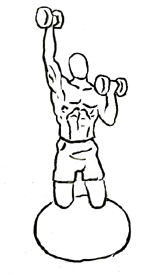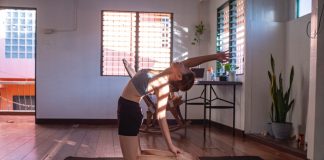Last Updated on September 30, 2014
Strength training is an essential component of any well-rounded fitness routine. Not only does it help build muscle and increase endurance, but it also improves your posture, balance, and overall functionality. Among the countless exercises out there, combining different movements into one advanced move can supercharge your workouts, working multiple muscle groups at once. One such exercise is the Biceps Curl with Overhead Extension using Dumbbells on a Stability Ball.
This exercise targets your biceps and triceps, while also engaging your core, back, and balance muscles. This makes it a powerful movement for anyone looking to elevate their fitness game. In this blog, we’ll dive into how you can effectively perform this advanced exercise, its benefits, and why incorporating it into your routine can help you achieve better overall fitness.
Why the Stability Ball?
Before jumping into the technicalities, let’s understand why the stability ball is crucial in this exercise. The primary role of the stability ball is to challenge your core stability. When you perform an exercise on an unstable surface like the stability ball, your core and stabilizing muscles have to work overtime to maintain balance. This engagement leads to stronger core muscles, which in turn improves balance, posture, and overall body coordination. Working out on an unstable surface like this helps improve your neuromuscular coordination — the communication between your brain and muscles.
Breaking Down the Exercise
Step 1: Set Yourself Up for Success
This exercise demands that you already have a good sense of balance, so if you are not comfortable kneeling on a stability ball, practice that first. Start by kneeling on the ball and holding onto something sturdy until you can balance on your own. Once you’re confident with your balance, you can progress to incorporating dumbbells.
- Starting Position: Grab a pair of dumbbells, holding one in each hand. Your palms should be facing up (supinated grip). Begin by kneeling on a stability ball. Ensure that your core is engaged, your back is straight, and your abs are drawn in tight. This position helps protect your lower back and ensures that you’re using proper form.
- Tip: If you’re new to this exercise or stability ball workouts, begin with lighter weights to avoid injury and to help maintain control throughout the exercise.
Step 2: The Movement – Combining Biceps Curl and Triceps Extension
- Biceps Curl: Start by curling one arm toward your shoulder as if performing a traditional bicep curl. Be sure to keep your upper arm stable and avoid swinging the dumbbell. Keep your elbow close to your torso to isolate the bicep muscle effectively.
- Triceps Overhead Extension: Simultaneously, raise the other arm up above your head, keeping your elbow pointing forward. With control, bend your elbow and lower the dumbbell behind your head in a triceps extension. Focus on isolating the triceps by keeping your upper arm stationary throughout the movement.
- Alternate Movements: As you extend one arm in a triceps extension, lower the other arm in a biceps curl. Essentially, the arms are working in opposition: as one curls, the other extends. This movement creates a continuous flow, and you’ll feel a burn in both your biceps and triceps.
Step 3: Return to Start
After you’ve performed the full motion on both arms, return to the starting position by bringing the arms back to neutral. Repeat the movement for the desired number of repetitions (usually 10-12 reps per arm is a good place to start for muscle growth and endurance).
Form Tips:
- Maintain a strong core: Keep your abs tight throughout the exercise to protect your lower back and prevent instability on the ball.
- Focus on control: Avoid using momentum to lift the dumbbells. Instead, focus on a slow and controlled motion to effectively target the muscles.
- Breathing: Remember to breathe! Exhale as you curl and extend the dumbbells, and inhale as you return to the starting position.
Benefits of the Biceps Curl with Overhead Extension on a Stability Ball
This advanced exercise offers several key benefits:
1. Targets Multiple Muscle Groups
The primary muscles worked in this exercise are the biceps and triceps. However, due to the balancing aspect of kneeling on a stability ball, your core muscles — including the rectus abdominis, obliques, and transverse abdominis — are also heavily engaged. Additionally, your back muscles, especially those around the spine, are recruited to help maintain balance. This makes it a compound exercise, meaning you’re working multiple muscle groups simultaneously, resulting in a more efficient workout.
2. Improves Balance and Coordination
Since you’re performing the movement on an unstable surface (the stability ball), your body has to constantly adjust to keep you balanced. This helps improve your balance and coordination, which can benefit your performance in other exercises and activities.
3. Enhances Core Stability
The stability ball adds an extra level of difficulty to the exercise by forcing you to engage your core throughout the movement. Strong core muscles are essential for good posture, injury prevention, and performing daily tasks with ease.
4. Increases Functional Strength
This exercise mimics movements you might perform in everyday life, such as lifting objects overhead or carrying items in different directions. By training your muscles to work together in this way, you build functional strength that translates to better performance in your daily activities and sports.
5. Challenges Mental Focus
Balancing on a stability ball while performing a combination of movements requires intense mental focus. This can help you develop better body awareness, which is essential for mastering more advanced exercises and pushing past plateaus in your fitness journey.
Common Mistakes to Avoid
While this exercise is highly effective, there are some common mistakes to watch out for:
1. Arching the Lower Back
If you’re not engaging your core properly, it’s easy to arch your lower back, which can lead to injury. Make sure to keep your abs tight and your back straight throughout the movement.
2. Using Momentum
It’s tempting to use momentum to lift the weights, especially as you get tired. However, this takes the focus off the muscles you’re trying to target. Instead, focus on slow and controlled movements to get the most out of the exercise.
3. Poor Elbow Positioning
During the triceps extension, make sure your elbow stays close to your head and doesn’t flare out to the side. This helps keep the focus on the triceps.
4. Losing Balance
If you find yourself losing balance on the stability ball, reduce the weight you’re using or practice balancing without weights until you feel more confident.
Modifications for Beginners
If you’re new to this exercise or find balancing on the stability ball too challenging, you can modify it to suit your fitness level. Here are a few options:
1. Start on the Floor
Instead of kneeling on a stability ball, you can perform this exercise while kneeling on the floor or sitting on a bench. This will allow you to focus on the biceps curl and triceps extension without worrying about balance.
2. Use Lighter Weights
Start with lighter dumbbells to ensure you can maintain proper form throughout the exercise. As you get stronger and more confident with the movement, you can gradually increase the weight.
3. Stability Ball Support
If you’re working on your balance, try kneeling on the stability ball with a wall or sturdy surface nearby for support. This will help you build confidence and stability without the risk of falling off the ball.
Advanced Variations
Once you’ve mastered the basic movement, you can challenge yourself further by incorporating some advanced variations:
1. Add a Leg Lift
For an extra challenge, try lifting one leg off the ball while performing the biceps curl and triceps extension. This increases the difficulty by further destabilizing your position, forcing your core to work even harder.
2. Increase the Weight
As you get stronger, increase the weight of the dumbbells to keep your muscles challenged. Just be sure to maintain proper form as you increase the resistance.
3. Single-Arm Variation
For an even greater challenge, perform the exercise with one arm at a time while holding the other arm steady. This variation increases the demand on your stabilizing muscles and enhances unilateral strength (strength on one side of the body).
Safety Precautions
This is an advanced exercise that requires good balance, strength, and control. It’s always a good idea to work with a personal trainer or instructor to ensure you’re performing the movement correctly and safely. They can provide guidance on proper form and help you progress at a pace that’s appropriate for your fitness level.
Incorporating the Biceps Curl with Overhead Extension into Your Routine
If you’re looking for a way to spice up your workout routine and challenge your strength, balance, and coordination, the Biceps Curl with Overhead Extension on a Stability Ball is an excellent exercise to try. It combines two powerful movements — the biceps curl and the triceps extension — while engaging your core and stabilizing muscles, resulting in a full-body challenge.
By incorporating this exercise into your routine, you’ll not only build stronger arms, but also enhance your core stability, balance, and overall functional strength. Whether you’re a seasoned athlete or just looking to try something new, this advanced exercise can help you take your fitness to the next level.








